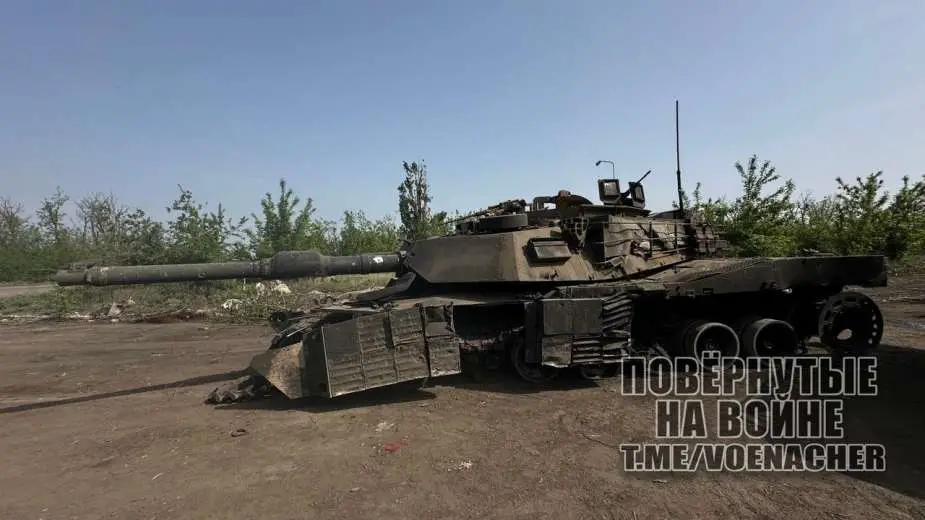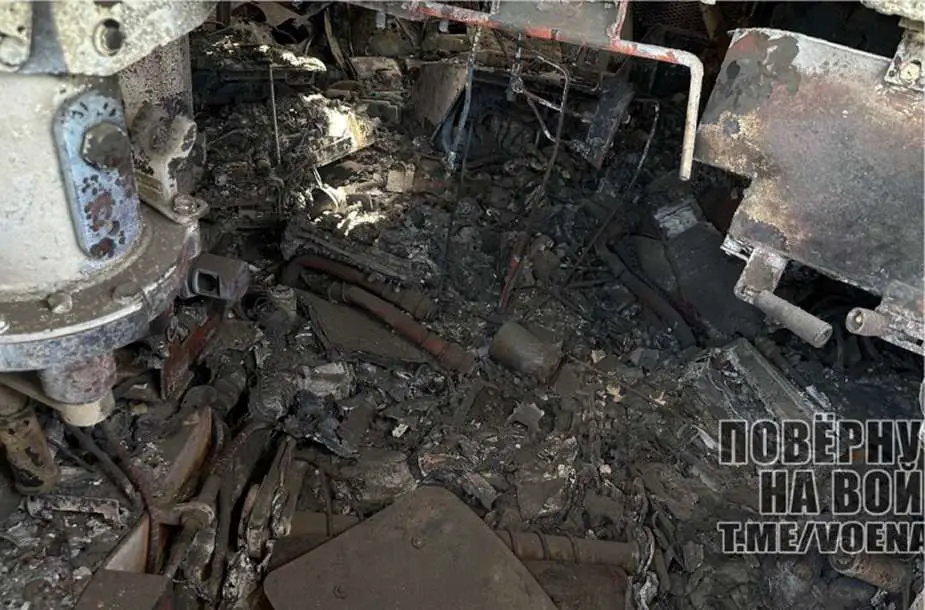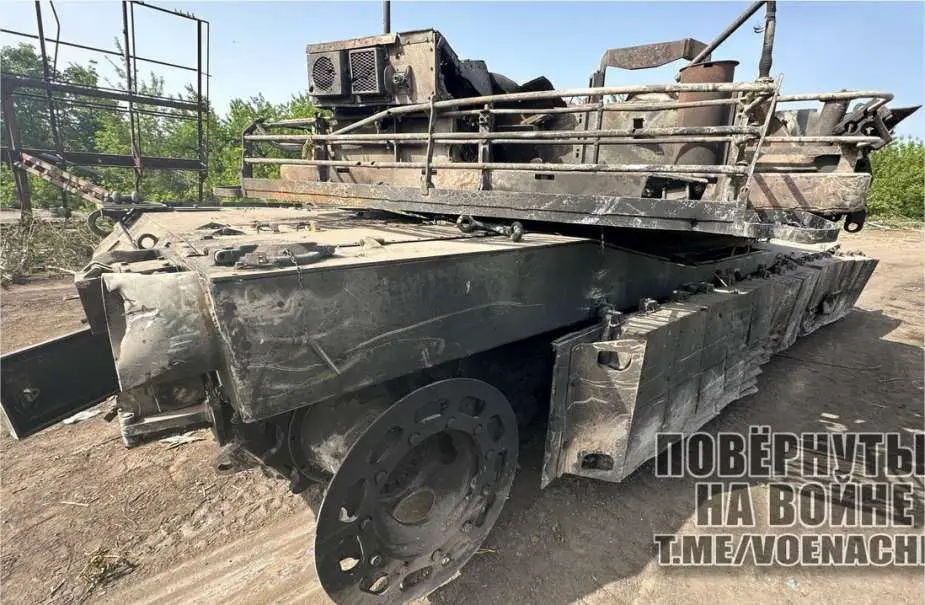- Army
- Conflicts in the world
- Israel - Iran conflict 2025
- Pakistan - India Conflict 2025
- Russia Ukraine War 2022
- Libya conflict day by day
- HAMAS - Israel War 2023
- Operation Serval in Mali French Army
- Sangaris operation Central African Republic
- Sangaris opération militaire République Centreafrique
- Ukraine - Russia conflict
- Syria conflict news
- Defence & Security Industry Technology
- Armies in the world
- Analysis Defense and Security Industry
- Conflicts in the world
- Navy
- Air
Russian forces capture first American M1A1 Abrams tank in Ukraine
On April 28, 2024, Russian forces captured an American M1A1 Abrams tank near Berdychi, which was significantly damaged, including internal burnout. Due to its substantial weight of nearly 67 tonnes, two BREM-1 recovery vehicles were employed to tow the tank. This incident marks the first Abrams tank captured by the Russian Armed Forces in Ukraine, as reported by the Russian Ministry of Defense.
Follow Army Recognition on Google News at this link

The tank will be part of a broader collection of NATO and Ukrainian equipment to be displayed at an exhibition titled "Dead Iron" on Moscow's Poklonnaya Hill. (Picture source: Russian social media)
The American tank will be part of a broader collection of NATO and Ukrainian equipment to be displayed at an exhibition titled "Dead Iron" on Moscow's Poklonnaya Hill. Scheduled to open on May 1, 2024, and last throughout the month, the exhibition will feature various pieces of military hardware including Bradley M2A2 and CV9040 infantry fighting vehicles and a Leopard 2A6 tank. According to Kremlin official Dmitry Peskov, the idea of the exhibition is to display equipment knocked out by Russian forces during their operations.
Alexander Savchuk, head of the group’s press center, stated that the Abrams tank, along with another recently secured near Berdychi, will be included in the upcoming exhibition. He noted that the public will have the opportunity to view these pieces up close. The exhibition has already attracted attention, with crowds gathering even before its opening.
The recovery and transportation of these pieces involved a detailed process managed by Russian engineering and repair groups. It included an initial engineering survey to ensure the safety of the personnel and equipment. The tanks were then transported to a facility for repairs, where they are undergoing restoration including the replacement of tracks, some elements of the electrical systems, and other major parts.
As reported by Army Recognition on February 27, 2024, the first loss of a US-supplied M1A1 Abrams tank deployed in Ukraine happened near Berdychi, close to Avdiivka. The tank, operated by Ukraine's 47th Mechanized Brigade, was initially immobilized by a Lancet drone and then struck by an anti-tank guided missile (ATGM). The operation was conducted by the Russian 15th Separate Guards Motorized Rifle Brigade, also known as the Black Hussars, and resulted in the disablement of the tank and the reported death of the tank’s driver. It is possible that this is the same tank that was captured by the Russian forces.
Further details indicate that the detection and engagement of the Abrams tank were managed by a drone operator from the Black Hussars, using the call sign "Rassvet", as the tank was spotted moving along Tsentralnaya and Mira streets in Berdychi, heading northeast towards Stepove, about one and a half kilometers from the forward Russian positions. Following the destruction of the tank, the Russian 15th Separate Guards Motorized Rifle Brigade publicly recognized the operation's success on their Telegram channel. Additionally, Russian actor and director Ivan Okhlobystin announced on the social network VKontakte that a reward of 10 million rubles (approximately $108,900) would be awarded to the soldiers involved in the destruction of the tank.

Even a heavily damaged and burnt M1A1 Abrams tank remains valuable for analysis by military engineers, as the structure and materials of the tank can provide critical insights into its manufacturing techniques and armor composition. (Picture source: Russian social media)
Even a heavily damaged and burnt M1A1 Abrams tank remains valuable for analysis by military engineers, such as those in Russia. The structure and materials of the tank can provide critical insights into its manufacturing techniques and armor composition. This allows for an understanding of the tank's vulnerabilities and strengths, which is beneficial for developing defensive tactics and enhancing the design of their own armored vehicles.
Moreover, any components that survive the damage — such as optical systems, communication equipment, and engine parts — are of interest for technical analysis. These components can help in assessing the technological standards of U.S. military hardware and identifying potential vulnerabilities, particularly in the areas of electronic warfare and cybersecurity. The study of such equipment also supports strategic military planning and has a major propaganda impact on the Russian population, reinforcing capabilities and morale through the demonstration of technical recovery and examination prowess.
The M1A1 Abrams Main Battle Tank is an updated variant of the original M1 Abrams, produced by General Dynamics Land Systems from August 1985 to early 1993. This version incorporates several enhancements such as an improved suspension system, upgraded armor protection, and a redesigned turret gun mount. Over 5,000 units were manufactured for the US Army and US Marines, and the tank has been adopted by several countries including Egypt, Australia, Iraq, Poland, and Ukraine. The modifications in the M1A1 Abrams address the changing needs of modern armored warfare, emphasizing advancements in firepower, protection, and mobility.
The main armament of the tank is the 120mm M256 smoothbore gun, which is capable of firing a variety of ammunition types. This includes the M829A1 APFSDS-T round, featuring a depleted uranium penetrator effective at distances up to 4,000 meters, and the M830 High Explosive Anti-Tank (HEAT) round, suitable for engaging fortified targets up to 3,000 meters away. The M1A1 is equipped to carry 40 rounds of 120mm ammunition, stored within the turret and hull. It also features a coaxial 7.62mm machine gun, an additional 7.62mm machine gun mounted on the turret, and a 12.7mm Browning M2 HB machine gun on the commander's hatch.
In terms of protection, the M1A1's armor integrates Chobham composite materials and depleted uranium plates, designed to defend against various ballistic and explosive threats. The tank's design prioritizes crew safety with compartmentalization and protective storage for ammunition. It is powered by a Honeywell AGT 1500 gas turbine engine, facilitating speeds up to 68 km/h and the capability to traverse diverse terrains. Additionally, the M1A1 includes a fire control system, laser range finder, night vision, and thermal sights, along with Nuclear, Biological, and Chemical (NBC) protection systems and an automatic fire extinguishing system, which contribute to its functionality in a range of combat environments.

The interior of the tank, completely carbonized, appears to offer few, if any, components that Russian engineers can analyze. (Picture source: Russian social media)

However, it does appear that this tank is equipped with M-19 Abrams Reactive Armor Tile (ARAT), which has been used by the US Army since 2006. (Picture source: Russian social media)

To make it presentable for the Moscow exhibition, this M1A1 Abrams might be fitted with T-80B wheels, similar to the captured Leopard 2A6. (Picture source: Russian social media)


























